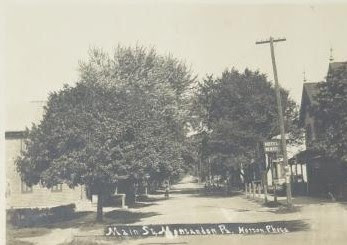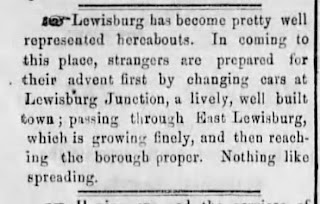In a list of how local towns got their names, I found this note that Montandon was named for a watch found in a well. That's not what the Keystone marker above says..but we'd need to find the whole story about the watch to know what the connection may be.
In 1840, Peter Waldron, a blacksmith from Lancaster County, located a short distance to the south of the Foresman building on the Sunbury and Milton road. The next improvement was a shoemaker shop, which was established by a Mr. Colby in 1848. The first justice of the peace in the community was Thomas Pardee, who filled that office for many years.
The first effort to establish a town was made by Francis and Jeremiah Church about the time the Pennsylvania canal was completed. The plan, which is on record in the county archives at Sunbury, exhibits a town plat between the canal and river, south of the Lewisburg crosscut, with Front street, Cherry alley, Jackson street, Montgomery, Church, Sarah's, Locust, and Dusty alleys and Wilson street parallel with the canal and river, intersected by Market and Green streets. The width of market is given as seventy-five feet, of Front and Jackson as sixty feet, and of Green, fifty-five feet. One hundred sixty lots are represented as having been laid out. This effort to establish a town no doubt indicated considerable enterprise on the part of the projectors, but the place failed to materialize. Owing in all probability to the fact that the country was not so thickly settled at that time as to require an intermediate trading point between Milton and Northumberland.
Upon the completion of the Philadelphia and Erie and the Lewisburg and Tyrone railroads the attempt to found a town was repeated under more favorable auspices. Up to this time the country was a farming district exclusively, with no other industries than the blacksmith and shoemaker shops mentioned in connection with the early settlement. In l861 P. Hackenberg bought of Cameron & Wall a lot lying to the east of the railroad and south of the Lewisburg and Danville road, upon which he erected a house and established therein the first store of the place in connection with the hotel business. In the same year, through the influence of Mr. Hackenberg, the first postoffice of the town was established with himself as postmaster. It was named Cameronia in honor of the Cameron family.
At this time the north side of the Lewisburg and Danville road belonged to the John Caul estate, and that to the south to Edward and Benjamin Hummel. In 1865 Lewis O. Hunner purchased a portion of the John Caul estate lying on tire east side of the Philadelphia and Erie railroad. In the same year the land belonging to Edward and Benjamin Hummel was purchased by John A. J. and Robert M. Cummings. Under the joint auspices of Messrs. Cummings and Hunner a town plat was surveyed in March, 1866, by David Rockefeller. The streets running east and west beginning at the northern extremity of the plat are Center, Main, the Lewisburg and Danville road, Cummings, and Chillisquaque. Those intersecting these and running north and south are Railroad and Northumberland, Railroad being the farther west. There were two houses here at that time. The first, built by Edward and Benjamin Hummel for use as a farm house, was purchased by John A. J. and Robert M. Cummings with the land they bought in 1865, and stands in relation to the above mentioned plan on the south side of Main near Railroad street. The second house erected is the hotel built by P. Hackenberg in 1861 on the southeast corner of Main and Railroad streets. In 1865 this building came into the possession of C. E. Hartman, who extended it to its present size and continued the hotel business for some time. This house has been used for the accommodation of the public since 1861, and is the only hotel in the town. The first house built after the survey of the town plat was that erected by Dr. N. C. Purdy, on the north side of Main street mid-way between Railroad and Northumberland streets.
Owing to the inconvenience caused by mail and express matter addressed to Cameronia going to Cameron county, the postoffice designation was changed to Montandon in 1867 through the influence of John A. J. and Robert M. Cummings, the name being suggested by the former. Circumstances have not favored the rapid expansion of the town, but by gradual growth it has attained a population of three hundred fifty, with three stores, one hotel, two churches, and shops of the various mechanics. " Bells History Of Northumberland County































































